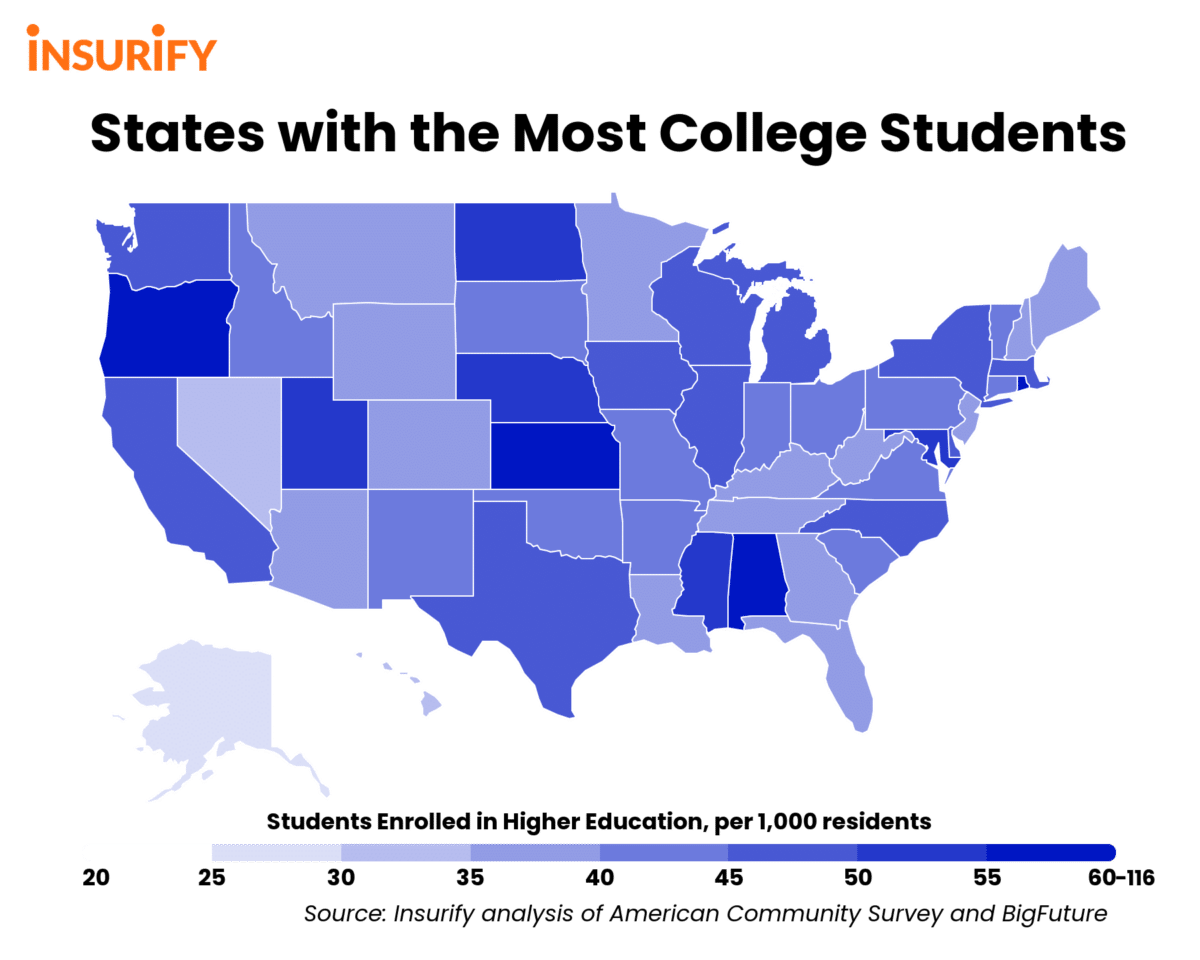
Risky Populations: States with the Most College Students
As colleges scramble to prepare for a safe school year in the midst of the pandemic, are they prepared to enforce safe social distancing among their students?
A whopping sixty-five percent of colleges and universities are preparing for in-person classes this fall, while only fourteen percent are proposing a hybrid model and a mere eight percent are preparing for a remote learning-only semester, according to the Chronicle of Higher Education. In the wake of this spring, when colleges and universities across the country closed their doors and switched to remote learning in the face of a much lower nationwide caseload, it may be quite shocking to find many of these same colleges planning to re-open their campus to students — especially with coronavirus cases now skyrocketing in dozens of states. However, many of these schools have decided to return to in-person classes this fall out of necessity. Switching to online learning is both time-consuming and costly. Some colleges lack the technological resources to do so, and all others, excluding the wealthiest, lack the financial flexibility to offer newly-remote students any discount on their tuition.
As a matter of fact, as colleges and universities navigate the new terrain of education in the coronavirus era, they need all the financial support they can get. Many institutions of higher education are struggling to stay afloat financially as they prepare a safe and virus-free learning environment for their students. Some have even closed permanently since March, with COVID-19 sounding their final death-knell. Yet, the president of the United States has other ideas. He recently implied that he would revoke non-profit higher-ed institutions’ current tax-exempt status, while also threatening to slash government funding of public higher-ed institutions. Community colleges and state universities rely heavily on state and federal funding to survive, and decreased funding at this time would be devastating.
Despite many colleges’ plans to resume in-person learning this fall, COVID-19 cases in the United States have been rising alarmingly among young adults. This increased spread is connected to college-related events, including house parties and drinking at off-campus bars. If thousands of students from all over the country come together this fall at more than half of the nation’s colleges and universities, spread among students and to nearby communities is all too likely. Even the most carefully formulated campus-wide social distancing guidelines mean nothing if students themselves do not comply. And of course, campuses are hardly self-contained. From grocery stores to places of worship, to nail salons, restaurants, and bars, many students regularly come into close proximity to local residents. Will colleges and universities become the next hot spots for the virus, despite the best efforts of their faculty and administration? Time will tell.
The data and research team at Insurify were interested in determining which states may be the hardest-hit by the arrival of students in the fall. To facilitate their analysis, they referred to data published by the United States Census Bureau and College Board’s planning tool, BigFuture, to identify the states with the largest college populations.

Insights
- National averages. When considering the total United States population, there are 44.57 students enrolled in higher education for every 1,000 Americans. Average funding given to state-funded colleges and universities annually is $1,862,445,000, and the average state spends 5.8 percent of its tax dollars on these institutions.
- States with the lowest college and university populations. The three states with the lowest share of college and university students are Hawaii, Nevada, and Alaska, with 25.35, 30.58, and 30.60 students for every 1,000 residents, respectively.
- Regional differences. While there is some variation in the average proportion of students enrolled in higher education by region — the Northeast, Midwest, West, and South have an average of 43.62, 44.60, 45.34, and 45.68 students for every 1,000 residents — this variation is not statistically significant.
- There’s no red/blue divide. While differences certainly exist between red and blue states, the proportion of college students to the general population is not one of them. Specifically, red states have 44.54 college students for every 1,000 residents, while blue states have 45.67 college students for every 1,000 residents. A t-test reveals no significant statistical difference between red and blue states on this metric. Where red and blue states may differ, however, is on the precautions their higher education institutions take when reopening for the fall.
Methodology
To identify the states with the highest university population, the researchers at Insurify, a home insurance comparison website, referred to data published by the College Board and the United States Census Bureau. College and university enrollment statistics, including community college and vocational school enrollment, were gathered from BigFuture, College Board’s college planning tool. Online enrollment was not included in the study.
Insurify’s researchers divided these numbers by the total population of each state, in order to compare enrollment statistics between states. Total population by state and population density by state were gathered from the United States Census Bureau’s most recent American Community Survey, published in December 2019.
Insurify’s researchers referred to the State Higher Education Finance report, for the fiscal year 2018, for data on each state’s expenditures towards higher education.
States With the Most College Students
10. Washington
- Students per 1,000 residents: 49.34 (10.7% above the national average)
- Population density: 114.6 residents per square mile
- Total higher education spending: $1,770,882,000
- Allocation of state budget to higher education: 4.8%
Washington kicks off the countdown with the tenth-highest proportion of college students to residents in the nation. Although the Evergreen State has dozens of publicly-funded institutions of higher education — 24 four-year colleges and universities, and 32 two-year institutions — the state allocates only a below-average proportion of its budget to higher education. Two of Washington’s three largest public universities, the University of Washington (31,000 students) and Western Washington University (15,000 students), plan to implement a hybrid learning model using both in-person and online learning this fall. Washington State University (25,000 students), on the other hand, is going fully remote.
9. North Dakota
- Students per 1,000 residents: 50.07 (12.3% above the national average)
- Population density: 11.0 residents per square mile
- Total higher education spending: $405,724,000
- Allocation of state budget to higher education: 8.1%
North Dakota has the ninth highest proportion of students to residents in the nation. Although this state has some of the smallest schools on this list — with only one college in the whole state having a student population over 10,000 — it has one of the highest proportions of students to residents in the nation, due in part to its population of only 762,062 residents. Students at North Dakota University, the state’s largest public university, will be welcomed back to campus in the fall but will be given the option of learning in-person or remotely.
8. Nebraska
- Students per 1,000 residents: 50.48 (13.3% above the national average)
- Population density: 25.2 residents per square mile
- Total higher education spending: $904,583,000
- Allocation of state budget to higher education: 9.3%
The second midwestern state to make the list, Nebraska has the eighth highest proportion of college students to residents in the nation. While not all of Nebraska’s institutions of higher education have released plans regarding the fall semester, the University of Nebraska, with the greatest student enrollment in the state — totalling over 43,000 students with campuses located in Lincoln, Omaha, and in Kearney — plans to resume in-person teaching in the fall semester.
7. Mississippi
- Students per 1,000 residents: 50.63 (13.6% above the national average)
- Population density: 63.4 residents per square mile
- Total higher education spending: $1,093,552,000
- Allocation of state budget to higher education: 10.1%
Mississippi has the seventh highest proportion of college students to state residents in the nation. The Magnolia state dedicates 10.1 percent of its budget each year to higher education, which is nearly twice the national average and the highest percent allocation on this list. Yet, many of the state’s public colleges and universities have chosen to resume in-person instruction this fall. Mississippi State University, and the University of Mississippi, the state’s two largest public universities, with an enrollment of over 16,000 and 18,000 students each, are two of them.
6. Maryland
- Students per 1,000 residents: 50.81 (14.0% above the national average)
- Population density: 622.9 residents per square mile
- Total higher education spending: $2,242,040,000
- Allocation of state budget to higher education: 6.0%
The second southern state to make the list, Maryland ranks sixth on the list with 14 percent more college students to residents than the national average and over 50 colleges and universities across the state. The University of Maryland is the state’s largest university, with over 60,000 students making up about 23 percent of the state’s total college population. The University plans to reopen on August 31, with in-person learning as usual. In the event of an outbreak during the fall semester, it will switch to online-only learning after Thanksgiving.
5. Utah
- Students per 1,000 residents: 52.35 (17.4% above the national average)
- Population density: 39.0 residents per square mile
- Total higher education spending: $933,252,000
- Allocation of state budget to higher education: 8.2%
Utah rounds out the top five states with a proportion of students to residents that is 17.4 percent above the national average. Despite the fact that the Beehive State allocates an above-average proportion of its budget to higher education, many publicly-funded schools plan to reopen with in-person learning in the fall. Utah Valley University, the largest of them all with an enrollment of over 28,000 students, is one example. Brigham-Young University, the state’s largest private university (with an enrollment of over 31,000) will welcome students back to campus this fall with a hybrid of in-person and online learning.
4. Kansas
- Students per 1,000 residents: 55.71 (25.0% above the national average)
- Population density: 35.6 residents per square mile
- Total higher education spending: $985,823,000
- Allocation of state budget to higher education: 7.5%
Kansas has the sixth-highest proportion of college students to residents and is the second midwestern state to make the list. Despite the fact that the Sunflower State allocates an above-average percentage of the state budget to higher education, many of its publicly-funded schools are planning to reopen their campus to students this fall, some with modified schedules. For example, the University of Kansas (18,000 students) and Kansas State University (17,000 students), the state’s two largest public universities, will begin the semester with in-person learning until Thanksgiving, after which final exams will be conducted online.
3. Oregon
- Students per 1,000 residents: 57.24 (28.4% above the national average)
- Population density: 43.9 residents per square mile
- Total higher education spending: $1,009,649,000
- Allocation of state budget to higher education: 5.3%
Oregon is the state with the third-highest proportion of students to residents in the nation, with 57.24 students per 1,000 residents. That said, the Beaver State allocates a below-average proportion of its budget to higher education. Colleges and universities throughout the state are taking a variety of approaches to teaching in the fall; for example, while the state’s largest community college, Portland Community College, will maintain a remote teaching environment throughout the fall semester, Oregon State University, the state’s largest public university, will resume in-person teaching.
2. Rhode Island
- Students per 1,000 residents: 61.85 (38.8% above the national average))
- Population density: 1024.5 residents per square mile
- Total higher education spending: $179,843,000
- Allocation of state budget to higher education: 2.9%
Rhode Island has the second-highest proportion of college students to residents in the nation. This northeastern state’s largest college “town” is the city of Providence, in which over half a dozen colleges and universities that attract nearly 40,000 students from all over the nation. In fact, this is 60 percent of the total number of college students enrolled in the state. The University of Rhode Island is the largest of the six located in Providence, with a student body of over 13,000, and will resume in-person learning this fall.
1. Alabama
- Students per 1,000 residents: 116.01 (160.3% above the national average)
- Population density: 96.8 residents per square mile
- Total higher education spending: $1,487,340,000
- Allocation of state budget to higher education: 9.5%
Alabama has the highest proportion of students to residents in the United States, with nearly 116 students per 1,000 residents. The state also allocates 9.5 percent of its budget to higher education, nearly twice as much as the national average. Alabama’s community college system currently plans to reopen its campuses for in-person learning in the fall, as does the University of Alabama, the state’s largest public university (over 31,000 students), among many others. However, the state is also dedicating a portion of the CARES funding it received to bolster online learning systems for higher-ed institutions in the state.
If you have questions or comments about this article, please contact insights@insurify.com.
In Pictures: What Education Looks Like Around the World During a Pandemic
More From Good Time Oldies 107.5






